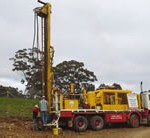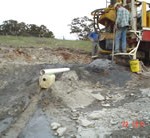All Bores need to be constructed to a minimum standard, specified in the minimum construction requirements for water bores in Australia (ARMCANZ, 1997) and to the satisfaction of the relevant water authority, here in Victoria generally Southern Rural Water or Goulburn Murray Rural Water.
However the minimum construction standard is a guideline only and should be used as a MINIMUM requirement. All new bores should in reality exceed this requirement.After locating a suitable aquifer, drilling is commenced with a variety of techniques, usually either Air Rotary or Mud. Air rotary relies on high volumes of compressed air to operate the cutting bit called the “hammer” and remove detritus from the bore. Air rotary is suitable for all hard rock formations as well as some unconsolidated formations such as sand and clay, providing the operator is sufficiently skilled in this type of drilling. Air rotary is by far the most common as it is the fastest and most efficient method in the above formations.
The Mud Rotary Water Boring technique relies upon mud as the media to not only remove detritus from the bore but also to stabilize and support the walls of the hole, thus preventing collapse and in some cases the outbreak of pressure water (artesian) from occurring. Mud drilling is not as fast or efficient as air or as popular for water boring, however it is often the only technique to use in certain formations, such as fine drift sands, running gravels and in artesian areas to prevent the outbreak of water under pressure. Mud drilling is predominantly used in the oil and gas industries for reasons of pressure control as well as hole stabilization.
Once water is encountered, the bore is cased, that is lined with PVC bore casing, generally of class9 wall thickness or larger. The bore must be lined the full depth of the bore to prevent collapse of the bore or the inflow of detritus. If the bore is not cased all the way to the bottom, then there is a high probability that the bore will collapse on top of the pump, locking the pump in the bore resulting in the loss of the pump and no water. Retrieval of a pump in such cases can be a costly and time consuming task with the chances of retrieving the water boring pump undamaged quite slim.
Once the casing has been installed full depth in the bore, the bore must then be developed to remove detritus and drilling slurry which will allow the bore to produce to its full capacity. Development of the bore is also necessary to produce clean clear sediment free water. If the drilling technique involved was mud rotary, then development can take significantly longer than for air rotary drilled holes. This is because the mud needs to be firstly broken down with detergents, into a less viscous format, then removed with an air lift technique. With an air blast drilled bore, generally development can proceed directly to air lift.
During development, the yield of the bore will be flow tested to determine water volume and flow rate available. This information is of course necessary to be able to correctly size a pump to the depth and yield of the bore.
After development and flow testing, the bore will then have a concrete surface pad erected around the top of the casing, for support and to impede surface contamination and is then capped. The bore is now ready for a pump/windmill to be installed.



